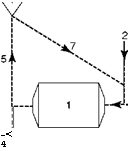Pulverized fuel firing involves a distinct milling plant and firing equipment. Milling deals with size reduction, while firing relates to combustion.
1. The milling plant consists of
A. Feeders to feed coal from bunkers to mills or pulverizers
B. Mills to grind the crushed coal
C. Pipes to transport the ground coal to burners
2. The firing equipment consists of
A. Burner assemblies complete with light-up systems
B. Burner management and safety system
A modern PF boiler works on
• Direct firing in which the milling plant and the boiler always work together
• Indirect firing in which a centralized milling plant feeds several boilers
Indirect firing was popular in the cement and metallurgical industry where PF firing was, in fact, first developed. A milling plant would grind a large amount of coal centrally, to be stored in coal bins. The milling plant would be several hundred meters away from the bins. Pulverized coal would be transported pneumatically and passed through cyclones mounted on top of bins for separation, and air dedusted in bag filters. Coal was dropped into the bins and the separated air released to the atmosphere. The coal powder was drawn at the bottom through feeders, pneumatically carried to boilers, and fired. Feeder speed varied as per the load demand.
Indirect firing was popular until the 1950s, and fairly large boilers were built. The milling and the firing were separated with the central milling plant working on a single-shift basis to fill the central bunkers common to a battery of boilers. Large tube mills would operate for 8-10 h a day at their best capacities so that the power costs would be low, and there was ample time for mill maintenance. The boilers operated at the required capacities, as there was enough PF available in the bunkers all the time. The following shortcomings hindered further growth.
• Indirect firing required high mill power.
• Powdered coal in the bins was susceptible to spontaneous combustion.
• Ground coal would absorb moisture and cause flow interruptions, leading to furnace explosions.
• Dusty environment.
• Untidy appearance and complicated layout.
The development of reliable and smaller vertical mills changed the course of PF firing dramatically.
• The vertical mills were lighter and lower in power consumption.
• The controllability of boiler and individual mill was better.
1. Horizontal ball and tube mill
2. 
|
8 |
![]()
|
11 |
![]()
|
6 |
![]() Raw coal inlet
Raw coal inlet
3.
|
I |
![]() Hot flue gas inlet
Hot flue gas inlet
4.
|
-< 4 |
 Mill bypass line
Mill bypass line
5.
|
9 |
![]() Mill discharge line
Mill discharge line
6. Classifier
7. Coarse particle return line
8. Cyclone separator
9. Pulverized coal bin
3 10. Suction fan
11.
|
9 |
![]() Vapor discharge
Vapor discharge
SHAPE \* MERGEFORMAT 
FIGURE 13.1
Indirect firing with ball mill under suction.
• This controllability paved the way for unified milling and firing, the boiler with its mills an independent unit.
• The coal bunkers stored the crushed coal, making the spontaneous combustion a relic of the past.
• With the ground coal immediately transported in the required amounts from mills to boilers directly, the fear of slug flows in the coal pipes leading to furnace explosions disappeared totally.
The vertical mills and direct firing led to the development of much bigger, flexible, and safer boilers with far superior dynamics. Although the indirect firing system has become obsolete, the large tube mills were made suitable for pressurized operation and used for stubborn applications such as grinding
• Very abrasive coals that would wear out the vertical mills
• Very high-ash coals, typically >45%
• Very low-volatile coals that need to be ground to a much greater fineness
Indirect firing using a ball mill is shown in Figure 13.1. Vertical mills were also employed in indirect firing.
In direct firing, where each boiler has a dedicated battery of the milling plant, the deficiencies of indirect firing were fully overcome. Figure 13.2 illustrates a typical direct-fired boiler equipped with vertical pressurized mills. Superior and larger mills paved way for the dramatic scale-up. Between the mid-1950s and the mid-1960s, there was a 10-fold increase in size that culminated in a 1300 MWe, boiler, as mentioned earlier.
In the direct-firing mode, there are two types of milling systems, namely,
1. Suction milling
2. Pressurized milling
Depending on whether the mill operation is under negative or positive pressure.
|
FIGURE 13.2 Direct firing with vertical mill under pressure. |



 13 сентября, 2013
13 сентября, 2013  admin
admin 
 Опубликовано в рубрике
Опубликовано в рубрике